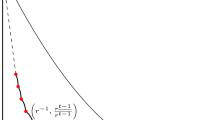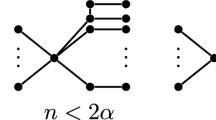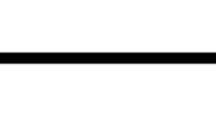Abstract.
A result of Balas and Yu (1989) states that the number of maximal independent sets of a graph G is at most δp+1, where δ is the number of pairs of vertices in G at distance 2, and p is the cardinality of a maximum induced matching in G. In this paper, we give an analogue of this result for hypergraphs and, more generally, for subsets of vectors ℬ in the product of n lattices ℒ=ℒ1×⋯×ℒ n , where the notion of an induced matching in G is replaced by a certain binary tree each internal node of which is mapped into ℬ. We show that our bounds may be nearly sharp for arbitrarily large hypergraphs and lattices. As an application, we prove that the number of maximal infeasible vectors xℒ=ℒ1×⋯×ℒ n for a system of polymatroid inequalities \({{f_1(x) \ge t_1,\ldots,f_r(x) \ge t_r}}\) does not exceed max{Q,βlog t/c(2Q,β)}, where β is the number of minimal feasible vectors for the system, \({{Q=|{{\mathcal L}}_1|+\ldots+|{{\mathcal L}}_n|}}\), \({{t=\hbox{max}\{t_1,\ldots,t_r\}}}\), and c(ρ,β) is the unique positive root of the equation 2c(ρc/ logβ−1)=1. This bound is nearly sharp for the Boolean case ℒ={0,1}n, and it allows for the efficient generation of all minimal feasible sets to a given system of polymatroid inequalities with quasi-polynomially bounded right-hand sides \({{t_1, \ldots, t_r}}\).
Similar content being viewed by others
References
Agrawal, R., Mannila, H., Srikant, R., Toivonen, H., Verkamo, A.I.: Fast discovery of association rules. In: Fayyad, U.M., Piatetsky-Shapiro, G., Smyth, P., Uthurusamy, R. (eds), Advances in Knowledge Discovery and Data Mining, pp. 307–328, AAAI Press, Menlo Park, California, 1996
Alekseev, V.E.: On the number of dead-end independent sets in graphs from hereditary classes. Combinatoric-algebraic methods in discrete optimization 6, 5–8 (1991), (Nizhni Novgorod, in Russian)
Balas, E., Yu, C.S.: On graphs with polynomially solvable maximal-weight clique problem. Networks 19, 247–253 (1989)
Boros, E., Elbassioni, K., Gurvich, V., Khachiyan, L.: An inequality for polymatroid functions and its applications, DIMACS Technical Report 2001-14, Rutgers University, http://dimacs.rutgers.edu/TechnicalReports/2001.html, to appear in Discrete Applied Mathematics
Boros, E., Elbassioni, K., Gurvich, V., Khachiyan, L.: Matroid Intersections, Polymatroid Inequalities, and Related Problems. In: Proc. 27th International Symposium on Mathematical Foundations of Computer Science (MFCS 2002), LNCS 2420, pp. 143–154, Poland, August 2002
Boros, E., Elbassioni, K., Gurvich, V., Khachiyan, L.: Generating Dual-Bounded Hypergraphs. Optimization Methods and Software. (OMS) 17(5), Part I, 749–781 (2002)
Boros, E., Gurvich, V., Khachiyan, L., Makino, K.: Dual bounded generating problems: partial and multiple transversals of a hypergraph. SIAM J. Comput. 30(6), 2036–2050 (2001)
Boros, E., Gurvich, V., Khachiyan, L., Makino, K.: On the complexity of generating maximal frequent and minimal infrequent sets. In: Proc. 19th International Symposium on Theoretical Aspects of Computer Science. (STACS), LNCS 2285, pp. 133–141, March 2002
Boros, E., Hammer, P.L., Hooker, J.N.: Predicting cause-effect relationships from incomplete discrete observations. SIAM Journal on Discrete Mathematics 7, 481–491 (1994)
Elbassioni, K.: Incremental Algorithms for Enumerating Extremal Solutions of Monotone Systems of Submodular inequalities and Their Applications. Ph.D. Thesis, Department of Computer Science, Rutgers University, New Jersey, 2002
Elbassioni, K.: An algorithm for dualization in products of lattices. In: Proc. 10th Annual European Symposium on Algorithms (ESA 2002). LNCS 2461, pp. 424–435, September, 2002
Fredman, M.L., Khachiyan, L.: On the complexity of dualization of monotone disjunctive normal forms. Journal of Algorithms 21, 618–628 (1996)
Liu, B., Ku, L.-P., Hsu, W.: Discovering interesting holes in data. In: Proc. IJCAI pp. 930–935, Nagoya, Japan, 1997
Liu, B., Wang, K., Mun, L.-F., Qi, X.-Z.: Using decision tree induction for discovering holes in data. In: Proc. 5th Pacific Rim International Conference on Artificial Intelligence, pp. 182–193, 1998
Lovász, L.: Submodular functions and convexity. In: Mathematical Programming: The State of the Art, Bonn 1982, pp. 235–257, (Springer Verlag, 1983)
Prisner, E.: Graphs with few cliques. Graph theory, combinatorics and algorithms, 1,2 (Kalamazoo, MI, 1992) 945–956, Wiley-Intersi. Publ., Wiley, New York, 1995
Srikant, R., Agrawal, R.: Mining generalized association rules. In: Proc. 21st International Conference on Very Large Data Bases, pp. 407–419, 1995
Srikant, R., Agrawal, R.: Mining quantitative association rules in large relational tables. In: Proc. the ACM-SIGMOD 1996 Conference on Management of Data, pp. 1–12, 1996
Author information
Authors and Affiliations
Corresponding author
Additional information
This research was supported by the National Science Foundation (Grant IIS-0118635), and by the Office of Naval Research (Grant N00014-92-J-1375). The second and third authors are also grateful for the partial support by DIMACS, the National Science Foundation's Center for Discrete Mathematics and Theoretical Computer Science.
Mathematics Subject Classification (2000): 20E28, 20G40, 20C20
Rights and permissions
About this article
Cite this article
Boros, E., Elbassioni, K., Gurvich, V. et al. Extending the Balas-Yu bounds on the number of maximal independent sets in graphs to hypergraphs and lattices. Math. Program., Ser. B 98, 355–368 (2003). https://doi.org/10.1007/s10107-003-0408-4
Received:
Revised:
Published:
Issue Date:
DOI: https://doi.org/10.1007/s10107-003-0408-4




